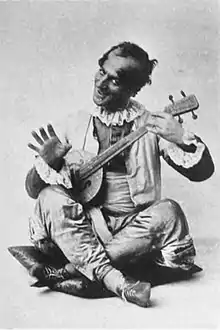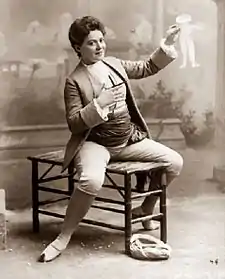| The Oolah | |
|---|---|
 Francis Wilson as the Oolah | |
| Written by | Charles Lecocq's La Jolie Persane, English libretto by Sydney Rosenfeld and J. Cheever Goodwin |
| Date premiered | 13 May 1889 |
| Place premiered | Broadway Theatre (41st Street) |
| Original language | French (liberally adapted to English) |
| Genre | comic opera |
| Setting | Persia |
The Oolah is an 1889 comic opera which starred Francis Wilson and Marie Jansen on Broadway.
Production
The opera is an adaptation of Charles Lecocq's La Jolie Persane, with a liberal adaptation of the libretto by Sydney Rosenfeld,[1] and script doctoring by J. Cheever Goodwin.[2][3][4]
Wilson originally planned to debut the play at the Casino Theatre (where Wilson had been a performer), but other obligations for that venue and contractual disputes caused delay and eventual failure. Thus, The Oolah opened at the former Broadway Theatre on 41st Street on May 13, 1889. The show marked Wilson's debut as a manager of his own company and as a Broadway star.[1][5][6]
The opening night did not go very well. Wilson had risked much of his money on the production, and was distraught. Rosenfeld refused to make changes without a new contract and a cut of the profits. This led to Godwin's immediate work to revise the text (including expanding Wilson's parts, as he was clearly an audience favorite), and to radical changes in the music, including three new songs from Woolson Morse, and two from John Braham,[7][8] and likely the scoring by Sousa mentioned below. One periodical commenting on the revisions noted Steele MacKaye's observation that "Plays are not written; they are rewritten," and concluded that "this seems to apply to comic operas especially."[7] Rosenfeld later sued Wilson over song rights.[9]
In any event, the changes worked, and the play had a successful run of 154 performances over 22 weeks,[10] closing on October 12,[11] and then went on tour.[2][12][13] A letter opener souvenir was given out to ticket holders at the 100th performance, a number of which are still extant.[14] The next season Wilson and Jansen had success with another French adaptation, The Merry Monarch.[4]
Sousa's role
John Philip Sousa likely orchestrated the music for Wilson, though this was not advertised. Wilson did not say in his autobiography who provided "the infusion of some whistlish and hummable melodies that set the audience in fine humor and their feet to keeping time," or who prepared "the orchestral arrangement to which had just come to hand as a performance began." Yet, Wilson claimed that some of the new music "was written by a composer while he was being whirled away to Chicago on the Pennsylvania 'Limited' train... he handed the manuscript to messenger awaiting him at Pittsburg, who hurried back to New York and placed it in our hands." And then it was performed the next evening.[2][15][16]
Songs
The popular songs of the show included "A Little Peach in an Orchard Grew" or "Listen to My Tale of Woe", a Wilson-Jansen duet which had previously been used in Nadjy. The lyrics which originated from Eugene Field and music and alterations by Hubbard T. Smith. Other popular songs included "Nobody Knows", as well as "Be Good", which Jansen performed, and was considered too suggestive by some.[17][18][4]
Plot
The play is set in Persia, where it is claimed that the marriage laws require a divorced wife who wishes to return to a husband must first marry another man, and then divorce that second spouse. "The Oolah" is the person who performs that role. However, the Oolah seeks to retire from his job to marry for real, yet he has one more professional marriage to accomplish first.[1][19]
The Oolah's most popular comedic lines included "think twice about divorcing once", and "I have been married a hundred and fifteen times and not once deceived. I have known men who have been married but once, but who were deceived a hundred and fifteen times."[19]
Original Broadway cast

- Boolahgoolah, the Oolah – Francis Wilson
- The Prince of Eriven – Hubert Wilke
- Akhalzakek – Charles Plunkett
- Nejef – Thomas H. Persse
- The Cadi – Harry MacDonough
- The Fig Dealer – Benjamin F. Johnson
- The Barber – Carlo Segelini
- The Tailor – W. Carr
- The Watchman – Henry Hoffman
- The Baker – H. Ledbury
- Darinoora – Laura Moore
- Bampoora – Elma Delaro
- Altoora – Ida Fitzhugh
- Shimrana – Ida Kissing
- Velis – Josie Winner
- Tourouloupi – Marie Jansen[2]
References
- 1 2 3 (12 May 1889). Mr. Wilson's New Venture, The New York Times
- 1 2 3 4 Wilson, Francis. Recollections of a Player, pp. 56-63 (1897)
- ↑ (Dec. 1896). The Stage, Munsey's Magazine, p. 371
- 1 2 3 (1 August 1891). Our Gallery in Players, The Illustrated American, p. 499
- ↑ (13 May 1889). Advertisement, The Sun (New York), p. 6, col. 4 (advertisement for opening night)
- ↑ Dale, Alan (14 May 1889). "The Oolah" (review), The Evening World
- 1 2 (22 August 1889). Dramatic and Musical Notes, America, p. 668
- ↑ (February 1902). About Francis Wilson, The Junior Munsey, pp. 875-76
- ↑ (14 November 1889). Songs in "The Oolah": Sydney Rosenfeld's Latest Suit Against Comedian Francis Wilson, The New York Times
- ↑ (6 October 1889). Francis Wilson, Manager; The Career of "The Oolah" and its Coming Tour in the Country, The New York Times
- ↑ (12 October 1889). Advertisement, The Evening World (advertisement for "farewell night")
- ↑ Chicago program (week of November 4, 1889)
- ↑ (21 December 1889). Massachusetts, New York Clipper (it played a month in Boston at the Globe Theatre)
- ↑ Letter Opener
- ↑ Warfield, Patrick. Making the March King: John Philip Sousa's Washington Years, 1854-1893, p. 136 (2013)
- ↑ Bierley, Paul E. The Works of John Philip Sousa, p. 165 (1984)
- ↑ "The Oolah" Will Have Fiftieth Performance, The Evening World (noting that 50th show will be Monday July 1, 1889; citing "Be Good" as "Marie Jansen's much discussed effort.")
- ↑ Whitney, Carrie Westlake. Kansas City, Missouri: Its History and Its People 1808-1908, Volume 1, pp. 379-81 (1908)
- 1 2 Bordman, Gerald, and Richard Norton. American Musical Theatre: A Chronicle 4th ed., p. 113 (2011)
External links
- Multiple photos of cast, at Museum of the City of New York
- Oolah Sheet Music, via Google books (1889) (alternate scan, with "Casino Theatre" reference on front cover corrected)
- Recording of "Listen to my tale of woe", sung by Sherman H. Dudley (1901), National Jukebox at Library of Congress (see also other recordings at Library of Congress)